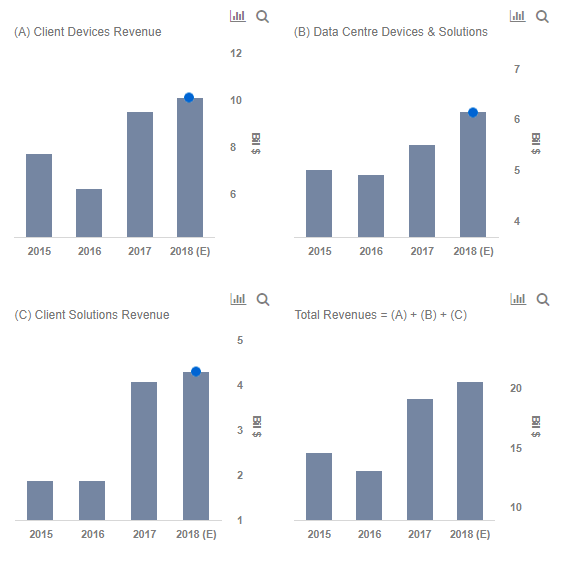What Are Western Digital’s Key Sources Of Revenue?
Western Digital (NASDAQ: WDC), one of the largest providers of data storage devices and solutions, operates three primary businesses – Data Center Devices and Solutions, Client Devices, and Client Solutions. Below, we expand on the products that these businesses cover, their historical performance, and our expectations going forward.
- Data Center Devices and Solutions includes nearline capacity helium hard drives for the data center market, enterprise-class HDDs for enterprise servers, and enterprise-class SSDs to support data analysis and other enterprise applications that usually require higher performance than those delivered by mechanical drives. This business contributes about 29% of Western Digital’s revenue and saw 11.7% growth in 2017 on the back of flourishing cloud-based enterprise storage demand.
- Client Devices, the largest division, encompasses storage devices for computing devices such as desktop, gaming consoles, laptop, and security surveillance systems. Furthermore, this business also includes NAND-flash embedded storage products for mobile phones and other portable products, and NAND-flash memory wafers. The 6% growth in 2017 was fueled by demand for client SSDs and strong adoption of iNAND, a new embedded flash product in Mobile OEM ecosystem.
- Client Solutions consists of HDDs, SSDs, and NAND-flash products in the form of external storage solutions such as USB drives, and enclosed portable storage solutions. Removable drives and other Flash-based products have been doing well of late.
We have created an interactive dashboard analysis that shows Western Digital’s key revenue sources and the expected 2018 performance. You can adjust the revenue drivers to see the impact on the overall revenues, EPS, and price estimate.
- Should You Pick Western Digital Stock At $65 After 25% Gains This Year?
- After Rising Over 30% In 2023 Is This Casino Stock A Better Pick Over Western Digital Stock?
- Which Is A Better Pick – Western Digital Stock Or Expedia?
- Will Western Digital Stock Rebound To Its Pre-Inflation Shock Highs?
- Will Western Digital Stock See Higher Levels After A 20% Rise This Year?
- Western Digital Stock Set For Bounce After Weak Post-Earnings Performance?
Stabilization Of NAND Supply To Boost Client SSD Sales
Western Digital’s sales growth in 2017 was slightly offset by a supply-demand imbalance for NAND which increased SSD prices, resulting in reduced adoption. However, the situation has stabilized now as supply has actually outpaced the demand. This should result in lower prices for NAND based drives, thereby narrowing the price difference between SSDs and HDDs. Consequently, the company should experience increased adoption of its mainstream client SSDs. Moreover, the company has started shipping 96-layer 3D NAND products to its retail customers, although at a smaller scale, which bodes well for the company. The company has planned to ramp up production further into the year. Furthermore, the company’s acquisition of SanDisk has proven to be a sound decision. SanDisk is one of the leading mobile flash storage suppliers in the world, and with large mobile manufacturers slated to release their products later in the year, we expect another strong contribution from the company.
Data Center Devices And Solutions To Continue Upward Trend
Given the success of enterprise drives, Western Digital expects greater than 65% growth in exabytes for 2018. This will be fueled by increasing demand for high capacity drives in data centers, artificial intelligence, and big data. Western Digital’s 10 terabytes and above capacity hard disks are doing well and we expect this to continue in the future. Also, the company recently released 14 terabyte helium drives that are more reliable and should cater to the ever-increasing needs of data management centers. Moreover, the technological advancements in enterprise SSDs have enabled the company to price its products competitively. This should result in stronger adoption of enterprise SSDs, as demand for high performance drives increases.
Finally, we maintain our $96 price estimate for Western Digital, which is ahead of the current market price. Disagree? Detailed steps to arrive at Western Digital’s price estimate are outlined in our interactive dashboard, and you can modify our assumptions to arrive at your own estimate for the company.
What’s behind Trefis? See How it’s Powering New Collaboration and What-Ifs
For CFOs and Finance Teams | Product, R&D, and Marketing Teams
Like our charts? Explore example interactive dashboards and create your own.

